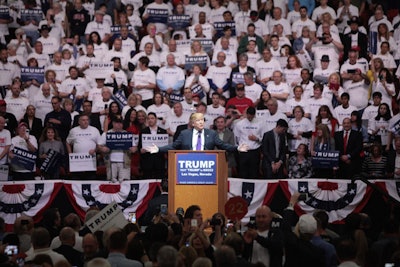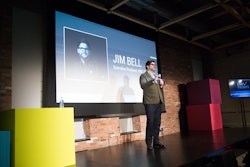
David Adler (@DavidAdler) is the C.E.O. and founder of BizBash.
President-elect Trump has announced his intention to continue with his rally format for mass events. In conjunction with his social-media reach of 23 million people, it has all become the “fireside chat” then never ends.
Unlike the typical political rally, the Trump rally—along with its digital counterparts on Facebook and Twitter—has borrowed from the best of event engagement thinking, for better or for worse. Live gatherings in the age of the YouTube star are a mélange of social media, PR, and face-to-face interaction.
It’s my contention that the Trump rally—similar to the new YouTube star celebrity events like the Digifest-style gatherings that focus on original social media stars—is changing the game by turning fans into mega fans after connecting in person.
It becomes the payoff for what author Ben Parr calls a para-social relationship, or a two-way relationship with a fictional character or celebrity. Social media has allowed followers to have a more intimate relationship with celebrities or sports heroes than with their own closest friends. Smart collaboration artists, brands, and event strategists are studying these new models for their own purposes. While many disagree with the results of the election, there is no doubt that the rallies were effective in creating a tribe of likeminded people.
About a year ago, I attended a talk that included Meridith Valiando Rojas and Chris Rojas, the married couple who co-created Digitour. The audience of “media elites” was amazed at the way their events were fueling the industry and filling stadiums and convention centers with die-hard fans who wanted to see their favorite YouTube stars in the flesh. According to Forbes, Digitour sold 300,000 tickets—primarily to 13- to 18-year-olds—for a 23-city tour, bringing in more than $20 million.
It’s clear how one of the biggest phenomena in events—social media events like Digitour—became a model for Trump’s rallies. These types of consumer events are filling stadiums, arenas, and convention centers, and because of their focus on social media, the events can count on the mega fans who attend to spread their message to the world.
The parallels between Digitour and the Trump-rally strategy may not to make sense on the surface, but if you then overlay the power of Donald Trump’s para-social relationship with his fans, the similarities are clear: The quest to meet in person is the fuel that makes these events a secret weapon.
For years I have been pointing out the power of face-to-face events, meetings, conferences, and festivals. For years we have gotten polite pats on the heads telling us how quaint and nice meetings and events are, but does anything really happen? Everything is changing and the science and academic leadership is backing this up, showing that live human connections add fuel to movements and passion to idea. Add the digital component of any type of relationship, and it extends engagement, multiplies the loyalty, and extends old-fashioned word of mouth.
Here are some of the changing dynamics that I see:
1. The chemical interconnection.
We have a new appreciation for the oxytocin exchange between people that used to be discussed only as the cuddling relationship between moms and their babies. Now its talked about as a powerful emotional connection between people.
2. Tribalization is reality.
Seth Godin, in his groundbreaking book Tribes, says that “A tribe is a group of people connected to one another. ... A group needs only two things to be a tribe: a shared interest and a way to communicate.” We can now find each other with the power of digital connections, but at some point humans have a need to gather in person. As we move from a hierarchical world to a networked world, tribes become even more important as a connector—leading to more live gatherings.
3. Ideas flow differently at live gatherings.
Alex Pentland’s book Social Physics: How Social Networks Can Make Us Smarter talks about how people are studying face-to-face interaction to design the new digital product, and how social interaction can become more effective by changing the cues and methods of creating serendipity so ideas can flow and interact in the same way neurons and cells interact in science. It made me understand that you can’t judge an event by how many people attend, but by how many conversations are inspired and conducted by the attendees in the room.
4. People crave intimacy.
As previously mentioned, Ben Parr, the author of Captivology, talks about the power of the para-social relationship. Think of the Kardashians, Taylor Swift, Oprah, and yes, Donald Trump. Social media gives us the appearance of a two-way relationship, since the celebrity or character you are relating to appears to be having a one-on-one conversation with you. The character shares the intimacy of his or her life that make you feel like you are friends. Donald Trump has been a master of this, with his famous Twitter account—and even when he gets into trouble you give him a pass because you know he is your vulgar friend. Since we crave intimacy, even bad behavior makes us feel we know the person better. You also have the unscripted way Trump speaks on stage. It’s real and has the same intimacy as that middle-of-the-night tweet. All of this continues the para-social relationship.
5. Events use the most powerful word in the English language.
Scott Heiferman, the founder of Meetup, says that the most powerful word in the English language is the word “let’s.” Whenever humans gather, they get to the “let’s”—let’s go to lunch, let’s start a business, let’s solve a problem, let’s start a revolution.
6. Give permission to talk to each other.
Heiferman’s other big takeaway is that people need permission to talk to each other. Most people, especially the younger generations, did not grow up knowing how to be social. I can be at a party and have a fear of saying hello to someone I don’t know or initiating a conversation. It’s easy to get people to speak to each other by giving them permission. All of a sudden, a room of 500 people has thousands of interactions in minutes. We need to recognize that to get to the “let’s,” people need to have permission to actually have conversations. These can be initiated by the speaker actually asking everyone to talk to each other, or by cues created by event organizers who promote the concept. This all explains the power of the Trump rally as a not-so-new new model for success.
If you look at the “social physics" of the rallies, you see the tribal nature of every aspect, especially with lines and long wait times; the waiting creates unlimited discussions and new relationships, forcing people who are standing together to engage in conversations that spread both new friendships and ideology. By the time they leave, a bunch of strangers are transformed to a tribe. The Trump rallies and the new social-media gatherings both create an atmosphere for ideas to flow and the creation of more connected tribes. My friend David Rich from George P. Johnson Company, who is a brilliant event strategist, says that we as event organizers create the “cues” to allow the idea-flow to result in an action.
So while we love the sizzle at events, the real reason for creating magnificent temporary environments that transport people from their everyday lives is to create the atmosphere to share ideas that result in action. In the case of the Trump campaign, I would suggest that the events were a critical part of the secret sauce that enabled all conventional wisdom to be turned on its head.



















